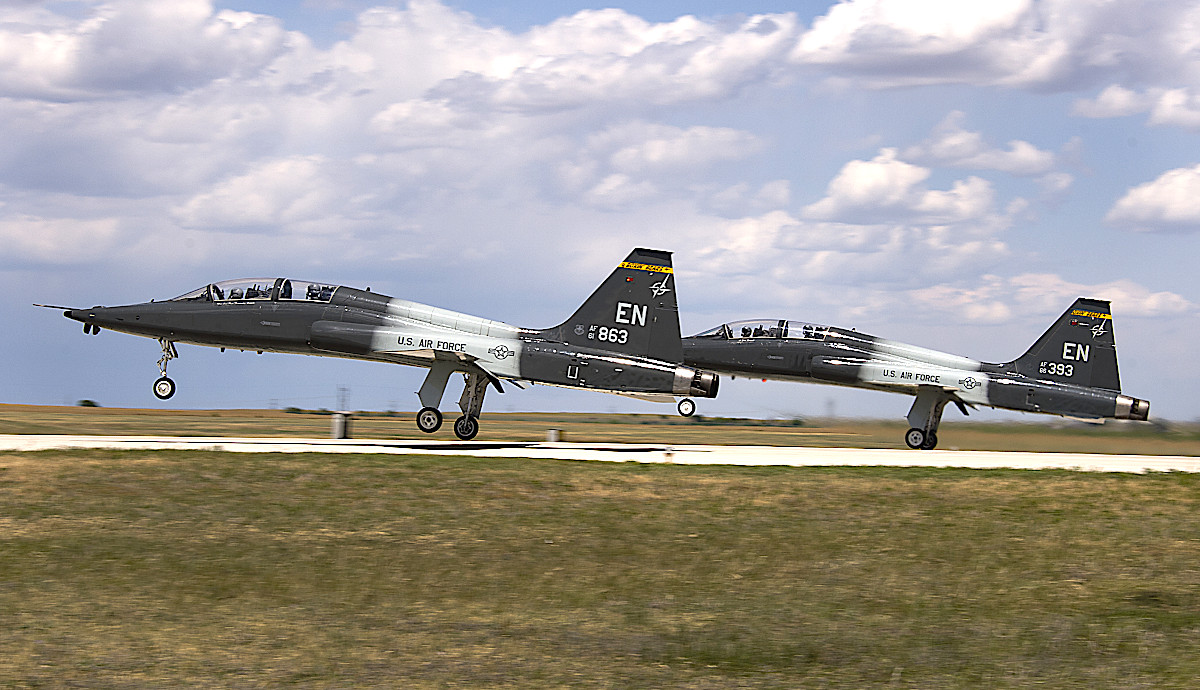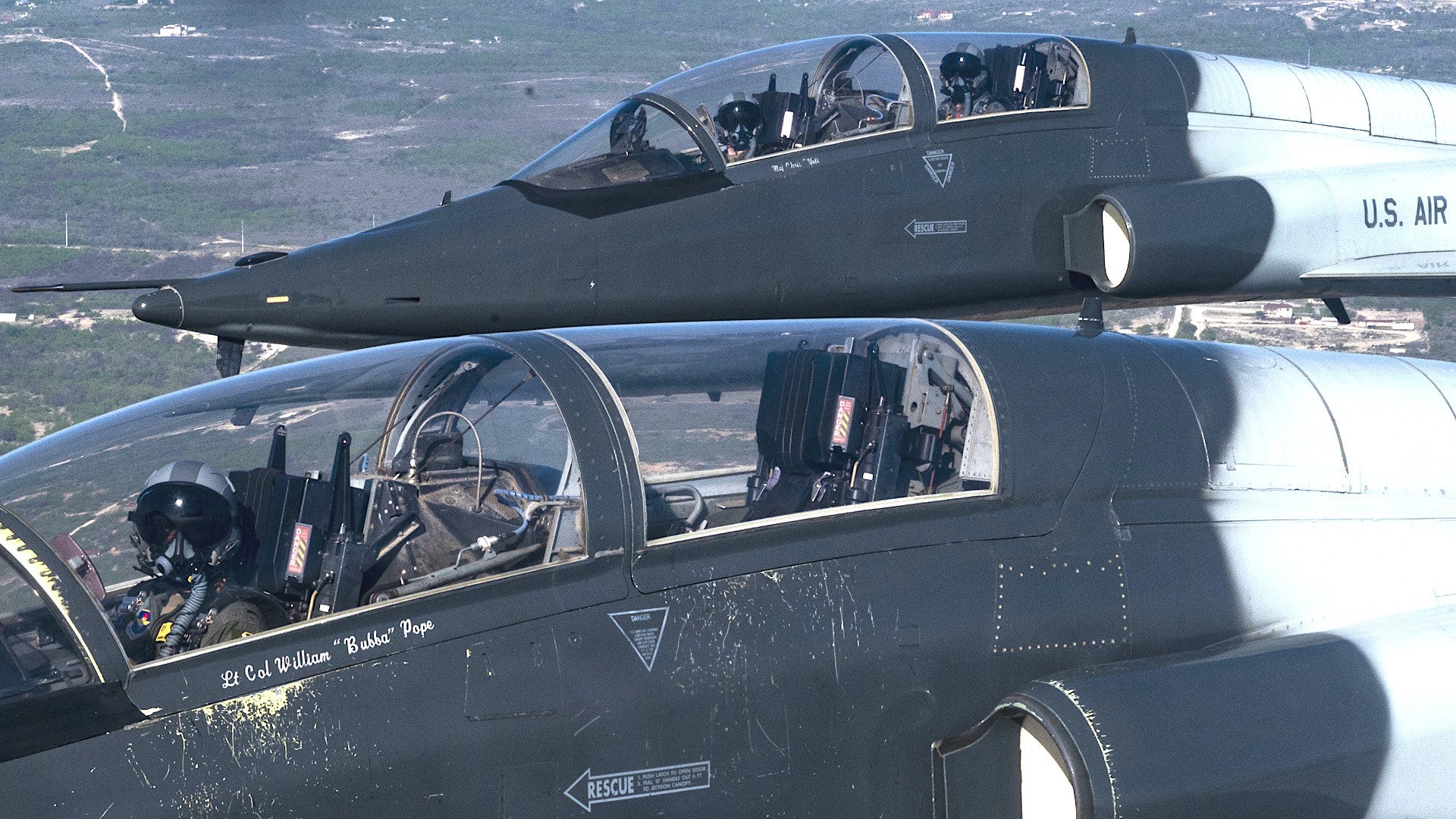Two T-38 Talon jet trainers that were involved in a fatal accident last month at Laughlin Air Force Base in Texas were performing a formation approach at the time, according to a report from the San Antonio Express-News newspaper. The Air Force has also now confirmed to The War Zone that Colonel Nathan Thompson, the second in command of the 47th Flying Training Wing, the main unit at Laughlin, was in one of the jets at the time. T-38 pilots assigned to Air Education and Training Command units, such as the 47th, have been banned from conducting formation landings, a similar maneuver, in virtually all situations in the wake of a different deadly mishap two years ago.
The Air Force has released only limited information about this accident, which occurred on Nov. 19, 2021, so far, as can be found in The War Zone‘s own initial reporting. The San Antonio Express-News reported that the service would not even officially confirm whether or not the jets were taking off or landing at the time of the incident.
Images that emerged on social media afterward showed both jets had departed the runway, with one coming to rest upside down. The other was right side up, but had clearly suffered extensive damage, including having most of its nose torn off, as well the loss of parts of its right wing and tail.
“Three sources familiar with the incident said Col. Nathan A. Thompson, vice commander of the 47th Flying Training Wing, walked away from the crash,” according to the San Antonio Express-News. “Two of them said the jets were making a risky but permitted maneuver called a formation approach when they went down.”
“Regarding confirming specific aspects of the mishap, we will provide additional information after the accident investigation is completed,” Air Force Colonel Todd Vician, a spokesperson for Air Education and Training Command (AETC), told The War Zone when asked about the reported formation approach.
A formation approach involves two aircraft flying close together as they head back to base at the end of a mission, but only one aircraft lands at a time. This is different from a formation landing in which both planes touch down almost simultaneously, which is an important distinction.
“Formation landings have been prohibited except in emergency situations in Air Education and Training Command since March 5, 2020,” Vician did confirm to The War Zone. “Formation approaches are still conducted.”
That prohibition came in the course of the Air Force’s investigation into a mishap involving two T-38s at Vance Air Force Base in Oklahoma back in 2019. The service announced in May 2020 that it had concluded that the accident, which left two individuals dead, was the result of pilot error.

The pilot error determination notwithstanding, AETC banned future formation landings involving T-38s. In a statement in May 2020, the family of 2nd Lieutenant Travis Wilkie, one of the pilots who was killed, had said that the maneuver was “dangerous and wholly unnecessary” and offered “no continuing practical benefit to combat pilot proficiency or survivability.”
With regards to formation approaches, “a commonly accepted practice is for flight leads to maintain an airspeed slightly faster than the calculated final approach speed until transition to landing,” the Air Force’s publicly released report on the 2019 accident had said. “This reduces the risk the wingman will become dangerously slow while making corrections to maintain formation position.”
As already noted, Colonel Vician, the AETC spokesperson, did also tell The War Zone that Colonel Nathan Thompson was involved in this mishap, something that the San Antonio Express-News had reported that it had been unable to confirm. The Air Force, like the rest of the U.S. military, does not typically release the names of individuals involved in mishaps, but who survive, as a matter of policy. As such, the service had previously publicly identified 2nd Lieutenant Anthony Wentz, who died in the accident, but not the other two people who were involved. The third person, reportedly another instructor pilot, who remains in critical condition, has yet to be identified, officially or otherwise.
The Air Force’s flight training community, and the T-38 portion of it in particular, has suffered a number of other accidents, many of which have been fatal, in recent years, in general. All of this also comes as the service is in the midst of exploring significant potential changes to its flight training regimens, which could involve less time in the cockpit in favor of simulated training environments, something that has been controversial.
Though the Air Force is still investigating last month’s accident, if it does turn out that the two aircraft were conducting a formation approach at the time, it could, if nothing else, put that maneuver under new scrutiny.
Contact the author: joe@thedrive.com
